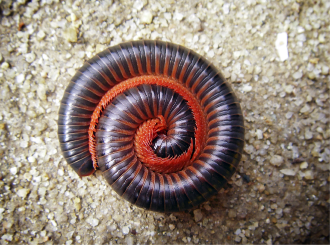Diplopoda
 | |
| Kingdom: | Animalia |
|---|---|
| Subkingdom: | Bilateria |
| Infrakingdom: | Protostomia |
| Superphylum: | Ecdysozoa |
| Phylum: | Arthropoda |
| Subphylum: | Myriapoda |
| Class: | Diplopoda |
Diplopods, more commonly known as millipedes, are long, segmented invertebrates belonging to the subphylum Myriapoda. The Latin meaning of the name Diplopoda, 'having double feet', refers to the distinctive features of millipedes, in which they possess two pairs of legs per body segment [2][3]. While their common name means 'thousand feet', most millipede species possess 47 to 197 pairs of legs[4]. However, in 2020, the first millipede species with over one thousand legs was discovered in Western Australia — Eumillipes persephone, with 1,306 legs[5].
Characteristics and Morphology
Most millipedes are long and either cylindrical or flat in shape. However, pill millipedes, belonging to the family Glomeridae, are stout and resemble isopods and, in similar fashion, can roll into a ball when disturbed.[6]. Most millipede species have hard, calcareous exoskeletons that protect them from predators and large forces faced when burrowing in soil[7]. Millipedes may roll into a spiral as a defense mechanism, where their harder exoskeleton on the top of each of their body segments, or tergites, protect their legs and more vulnerable underside. Millipedes lack a waxy layer on their epicuticle, making them vulnerable to desiccation[8]. The size of millipedes vary greatly across different species, with the smaller species measuring at around 2 mm long and the largest species, Archispirostreptus gigas, growing up to 13 inches long[4]. They bear a head with one pair of antennae, a pair of simple eyes known as ocelli, and a mouth. Their mouths consist of an upper lip (labrum), a pair of mandibles, and a grinding plate (gnathochilarium). The rest of their bodies are made up of many segments, with the number of segments varying with species and age. The first segment connected to the head, called the collum, has no legs and is also present in their closest relative clade Pauropoda. The following three segments bear only one pair of legs. Succeeding segments bear two pairs of legs, while the final few segments bear no legs. The last segment, called the telson, has a pair of anal valves which can open to release feces from the millipedes' digestive tract[9][3]. Millipedes move fairly slowly compared to their centipede relatives belonging to the subphylum Chilopoda. They move their legs in a wave-like motion, referred to as metachronal locomotion. Their many legs can produce a surprising amount of force, necessary to direct themselves when burrowing[10]. Many millipede species possess glands called ozopores that run along the length of their bodies and can release chemical compounds that may be toxic or repel certain parasitic or predatory organisms. The chemicals secreted vary across species and include but are not limited to hydrogen cyanide, p-benzoquinones, phenols, and terpenoids. Millipedes that bear ozopores often have bright aposematic coloring. Other species that do not secrete defensive chemicals may bear similar coloring patterns as a result of Mullerian mimicry[9][11]. While these secretions may be irritating or toxic to certain organisms, other organisms may use millipede secretions to their advantage. Black lemurs (Eulemur macaco) have been observed biting millipedes and rubbing their defensive secretions on their bodies. Research has shown that the lemurs may do this to repel insects such as mosquitoes, but the they also seem to enter an intoxicated state[12]. Other research shows that these defensive secretions may also attract predators such as dung beetles[13].
Reproduction and Life Cycle
Diet and Feeding Behaviors
Distribution
References
- ↑ Integrated Taxonomic Information System (ITIS). n.d. Diplopoda. https://itis.gov/servlet/SingleRpt/SingleRpt?search_topic=TSN&search_value=154409#null
- ↑ Merriam-Webster. n.d. Diplopoda. https://www.merriam-webster.com/dictionary/Diplopoda
- ↑ 3.0 3.1 Hennen, D. & Brown, J. n.d. Millipedes of Ohio Field Guide. Ohio Division of Wildlife. chrome-extension://efaidnbmnnnibpcajpcglclefindmkaj/https://dam.assets.ohio.gov/image/upload/ohiodnr.gov/documents/wildlife/backyard-wildlife/Millipedes%20of%20Ohio%20Pub%205527.pdf
- ↑ 4.0 4.1 Tohono Chul. n.d. Millipede Facts. chrome-extension://efaidnbmnnnibpcajpcglclefindmkaj/https://tohonochul.org/wp-content/uploads/2020/07/Millipede_Facts_Worksheet.pdf
- ↑ Marek, P., et al. (2021). The first true millipede—1306 legs long. Scientific Reports. https://www.nature.com/articles/s41598-021-02447-0
- ↑ Australian Museum. (2020). Pill Millipedes. https://australian.museum/learn/animals/centipedes/pill-millipedes/
- ↑ Borrel, B. (2004). Mechanical properties of calcified exoskeleton from the neotropical millipede, Nyssodesmus python. Journal of Insect Physiology. https://www.sciencedirect.com/science/article/abs/pii/S0022191004001593
- ↑ Coleman, D.C., M.A. Callaham Jr., & D.A. Crossley Jr. (2017). Fundamentals of Soil Ecology - 3rd Edition. Academic Press.
- ↑ 9.0 9.1 Sierwald, P. & J.E. Bond. (2007). Current Status of the Myriapod Class Diplopoda (Millipedes):Taxonomic Diversity and Phylogeny. Annual Review of Entomology. https://pubmed.ncbi.nlm.nih.gov/17163800/
- ↑ Garcia, A. et al. (2021). Fundamental understanding of millipede morphology and locomotion dynamics. Bioinspiration & Biomimetics. https://pubmed.ncbi.nlm.nih.gov/33007767/
- ↑ Shear, W.A. (2015). The chemical defenses of millipedes (diplopoda): Biochemistry, physiology and ecology. Biochemical Systematics and Ecology. https://www.sciencedirect.com/science/article/abs/pii/S0305197815001167
- ↑ Banerji, U. (2016). Lemurs Get High on Their Millipede Supply. Atlas Obscura. https://www.atlasobscura.com/articles/lemurs-get-high-on-their-millipede-supply
- ↑ Rodríguez‑López, M.E. et al. (2021). Attraction of Canthon vazquezae (Coleoptera: Scarabaeinae) to Volatiles Released by Messicobolus magnificus (Diplopoda: Spirobolida). Journal or Insect Behavior. https://link.springer.com/article/10.1007/s10905-021-09785-x
- ↑ Marek, P. et al. (2014). A species catalog the millipede family Xystodesmidae (Diplopoda: Polydesmida). Virginia Museum of Natural History. https://www.researchgate.net/publication/267810849_A_species_catalog_the_millipede_family_Xystodesmidae_Diplopoda_Polydesmida